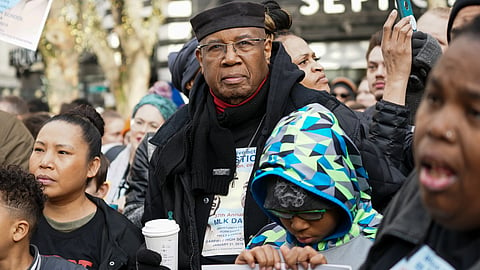Remembering Tony Orange as a Young Activist
by Sharon Maeda
Anthony "Tony" Orange grew up in Houston and started college in Los Angeles, but he made his mark in Seattle where he became revered for his social justice activism and advocacy work, over more than 50 years. Late last month, Tony lost his long battle with cancer.
Retired King County Councilmember Larry Gossett knew him well and shared stories of his friend with fellow civil rights legend Eddie Rye, Jr. on KKNW. Gossett told of first meeting Tony in 1967, at the West Coast Black Youth Conference in Los Angeles.
There, Gossett and EJ Brisker were introduced to Tony, Lynn French and Mike Williams from the Student Non-Violent Coordinating Committee (SNCC) started by Ella Baker. Tony was particularly pleased to see college athletes participate in the conference, including John Carlos and Tommie Smith who would later earn global fame, after they stood on the 1968 Olympics winners' podium with their black-gloved clenched fists in the air in solidarity with the civil rights movement.
Two years later, Tony followed French and Williams to Seattle as transfer students to the UW Educational Opportunities Program (EOP). Gossett recalled that Tony immediately wanted to know when the next SNCC or BSU meeting was going to happen — striving to become involved with the local civil rights scene as soon as he could.
But, Tony also found plenty of time to enjoy campus life. French remembers that the three of them felt they had to "work twice as hard" to compete with the other students. So, they had their own study group at 7 a.m. on Saturday mornings. Tony was the first to fall away for having stayed up too late Friday night. His friends were focused on academics with eyes on advanced degrees; Tony's focus was always advocacy for the Black community.
Tony distinguished himself as a student activist and I advocated hiring him as the first student Peer Counselor in the UW's Student Activities office. His desk in 207 HUB (Husky Union Building) was right behind mine so we bantered for hours, often forcing me to work late to catch up on administrative work.
Technically, as the only person of color on the staff, I was supposed to be his mentor, but Tony often schooled me. He always had questions that forced me to rethink, refine and improve my strategies to support campus student leadership. At meetings, he had a unique style: he always spoke last. He listened to everyone, synthesized what was said, asked questions — always the questions — then left the solution in the air for the rest of us to decide. "Why do you think that will work? Is that going to get you the results?"
French recalls that Tony mastered that strategy from Rock Bottom, the book by James Forman, a national SNCC and civil rights leader. The book promoted open-ended questions rather than organizing prescriptions as a tool for movement building. One example, it asked the reader to define leadership. This forced young SNCC members to probe deeper into their organizing methods and think through answers to the book's questions. "We admired [Tony]; he could ask those questions," added French.
I had no idea the source of Tony's methods, but even decades later, when in the middle of circular discussions, I would remember Tony — and as difficult as it was for me not to speak up right away — I would wait until everyone had spoken, asked questions, and we jointly came to more strategic conclusions.
After the UW, Tony moved on to a number of key positions, advocating for justice for the Black community including serving in then Governor Mike Lowry's administration as head of the Washington State Commission on African American Affairs and other advocacy positions in the city and community — including the NAACP and Central Area Motivation Program (CAMP) — and was a voice for the community on many boards and commissions.
Tony loved community events and was never too busy to organize them. He was a founding member of and fixture at the annual Martin Luther King, Jr. Day teach-in and celebration at Garfield High School. Every year, he wandered the halls of Garfield checking out the community education tables, workshops and job fairs like a proud father. And, he was always in the front of the march to downtown that followed.
As his health deteriorated and he became physically frail, Tony Orange never lost his fervor for social justice. And, if his body hadn't given out, he would have been right there with Black Lives Matter marching for justice for George Floyd and all the others who have been killed at the hands of police.
Tony Orange, Seattle is better for your advocacy, and we will miss you.
Sharon Maeda is Interim Managing Editor of the Emerald.
Featured image: Tony Orange (Photo: Susan Fried)
Help keep BIPOC-led, community-powered journalism free — become a Rainmaker today.


